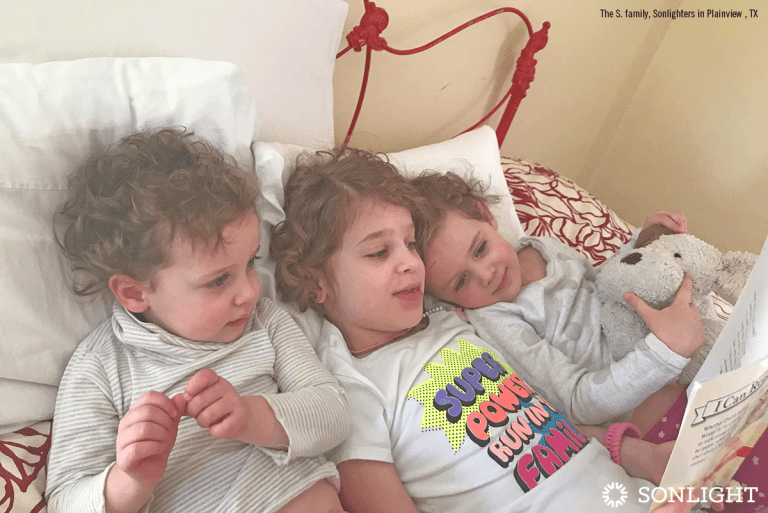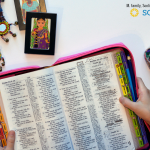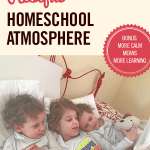
The moment you step into a spa, something changes. You relax your shoulders and breathe deeply, drinking in your surroundings. Enveloped by a calming aroma, cozy lighting, and soft music, you exhale slowly, admiring the clean, clutter-free atmosphere around you. Yes, spas are restful because you’re temporarily released from your responsibilities—but they’re also restful in large part due to thoughtfully created environments of rest. Would we go to
- a spa to relax,
- a library to study,
- a coffee shop to write, or
- into nature to unwind
if these places were cluttered, dirty, loud, or filled with tension?
Environment matters. And in our homeschools, atmosphere matters, too.
I’ll preface this by saying I’m not perfect. I don’t have a seven-step plan to achieve platinum status in housekeeping ; I’m not the de-cluttering guru of joy-sparking fame. I leave my bed unmade—and cereal bowls on the counter—more often than I’d like to admit. See, the truth is, this doesn’t come naturally to me. But tidiness doesn’t spontaneously occur for anyone; even expert-level homemakers and organizers. Being tidy doesn’t just happen. Being tidy involves work. But I work at it—and continue working at it—because I know aesthetics make a big difference. I can
- focus for longer periods of time,
- think more clearly, and
- maintain a patient attitude more easily
in a pleasant environment, than I can in a cluttered one.
And I definitely feel less stressed in a clean space. Compared to adults, most kids are even more distractible—so imagine the impact a disorderly environment has on children.
This one key to a restful homeschool environment is removing clutter.
Overwhelming Visual Environments Can Disrupt Learning
A 2014 study published in Psychological Science revealed kids were “more distracted by the visual environment, spent more time off task, and demonstrated smaller learning gains when the [classroom] walls were highly decorated than when the decorations were removed.”
If you haven’t been inside a traditional school classroom in the last several years, you might be shocked at the current trend to paper the walls with discordant decor of every remotely-educational variety. It’s become an entire money-making industry. (When I toured a small Christian school before making the decision to homeschool, even the ceilings were decorated. I could hardly catch my breath.)
Teachers I’ve chatted with admit Pinterest-obsession has taken over preparation, with many instructors trying to outdo each other with increasingly-gaudy classrooms. Pyschological Science refers to much of this decor as “displays that are not relevant to ongoing instruction.”And as the study and many others like it concluded, these visually-overwhelming displays actually disrupt children’s education.
Cluttered Home Environments Can Disrupt Learning
Most homeschoolers have not recreated the classroom look. Even those who do find educational posters useful do not generally hang them up en masse as seen in the classroom. We haven’t papered the walls with hall passes and behavioral charts. We don’t have rows of primary-colored cubbies or dozens of lined-up clipboards, and we haven’t placed laminated instructions next to every object.
- But are we reading, squished up next to a laundry basket on the couch?
- Are we working on neat and precise handwriting with our notebooks pushed up against dirty dishes on a tabletop that’s anything but neat?
Have we replaced the visual environment of school with the cluttered environment of home?
A Restful Homeschool Environment is a Few Habits Away
I’m not writing this to say I’ve arrived; I haven’t. I’m writing this to remind us all that the dozens of tiny things we do throughout the day matter. I’m writing this to remind myself of the sacred responsibility we have as mothers to cultivate a nurturing atmosphere for our children. As we see the clutter creeping, we can
- stop to put away the previous school subjects,
- sweep the three-hole punch confetti into the garbage can,
- walk through the house to collect abandoned drinking glasses, and
- load waiting dishes into the dishwasher.
We can also take a few moments to
- turn on soft, soothing music,
- restack the library books, and
- tuck the science experiment supplies back into the pantry.
Messes Don’t Have to be Our Identify as Homeschool Moms
In the short-run, it’s much easier not to do all that, isn’t it? But I’ve noticed when I skip these menial tasks—when I allow our environment to decay around us—our mood tends to correspondingly deteriorate. Our tempers flare, our fuses run sort. Peaceful atmosphere does not cure human nature, but a chaotic atmosphere doesn’t help it, either. It’s a shorter path to patience in a peaceful space than through the maze of a sprawling, discordant mess.
I live in the real world, and I know you do, too. A certain level of mess is inevitable when you live, work, eat, school, and sleep in the same space. But contrary to popular memes, chaos doesn’t mean we love our kids more. And messes don’t have to be our identity has homeschool moms.
For years, my mom homeschooled three kids through brutal northern winters while my dad worked second shift. She had her hands full. Everyone would have understood if our house reflected the intensity of the season, yet it rarely did. I’m not the clone of my mother by any means, but she taught us to be content and take care of what we had. A clean house doesn’t mean striving and keeping up with the Jones, just as an unkempt home does not mean holier hearts.
If you crave aesthetic beauty, don’t be ashamed. God created orderliness and beauty. If you are overwhelmed with clutter, and don’t know where to start, don’t be ashamed. God will walk with you step by step as you reclaim the physical space around you.
We Can Model the Balance Between Work and Rest
Let’s move toward balance, shall we? Let’s not advocate tidiness at the expense of family relationships, but let’s not slide down the scale toward chaos at the detriment of our families, either. We can practice habits and routines—life skills!—while at the same time speaking life to our children. Pausing for ten minutes to put away the laundry on the couch before we sit down to read aloud will
- model a good example for our children of balancing chores and rest,
- allow an opportunity to practice self-discipline,
- emphasize good habits and routine, and
- create an even more restful environment for us to share with our children.
Homeschooling with Sonlight is an orderly, yet restful, education. As we diligently work toward our goals, our homes, too, can reflect that same spirit of orderly rest.








